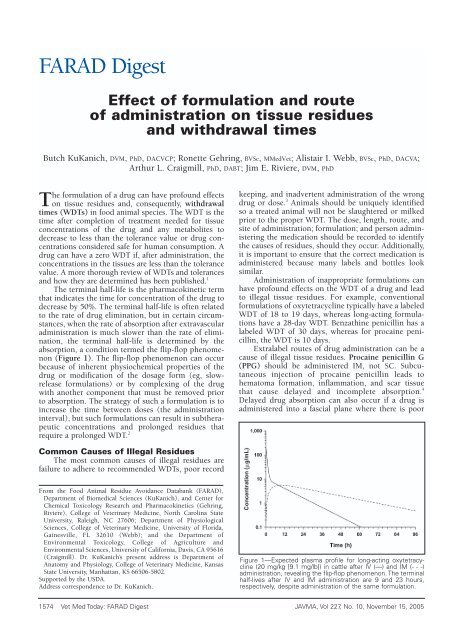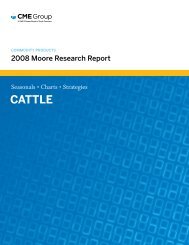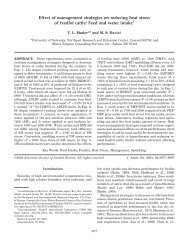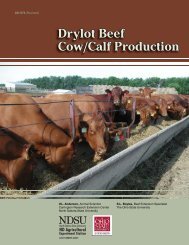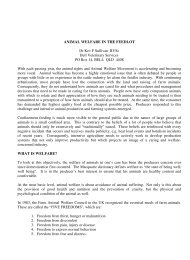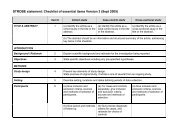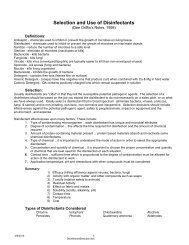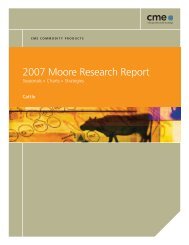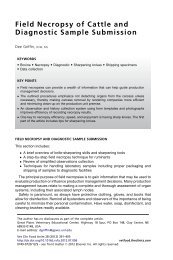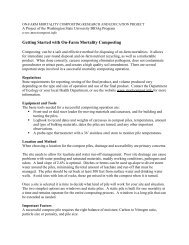FARAD Digest - Farad's
FARAD Digest - Farad's
FARAD Digest - Farad's
You also want an ePaper? Increase the reach of your titles
YUMPU automatically turns print PDFs into web optimized ePapers that Google loves.
<strong>FARAD</strong> <strong>Digest</strong><br />
Effect of formulation and route<br />
of administration on tissue residues<br />
and withdrawal times<br />
Butch KuKanich, DVM, PhD, DACVCP; Ronette Gehring, BVSc, MMedVet; Alistair I. Webb, BVSc, PhD, DACVA;<br />
Arthur L. Craigmill, PhD, DABT; Jim E. Riviere, DVM, PhD<br />
The formulation of a drug can have profound effects<br />
on tissue residues and, consequently, withdrawal<br />
times (WDTs) in food animal species. The WDT is the<br />
time after completion of treatment needed for tissue<br />
concentrations of the drug and any metabolites to<br />
decrease to less than the tolerance value or drug concentrations<br />
considered safe for human consumption. A<br />
drug can have a zero WDT if, after administration, the<br />
concentrations in the tissues are less than the tolerance<br />
value. A more thorough review of WDTs and tolerances<br />
and how they are determined has been published. 1<br />
The terminal half-life is the pharmacokinetic term<br />
that indicates the time for concentration of the drug to<br />
decrease by 50%. The terminal half-life is often related<br />
to the rate of drug elimination, but in certain circumstances,<br />
when the rate of absorption after extravascular<br />
administration is much slower than the rate of elimination,<br />
the terminal half-life is determined by the<br />
absorption, a condition termed the flip-flop phenomenon<br />
(Figure 1). The flip-flop phenomenon can occur<br />
because of inherent physiochemical properties of the<br />
drug or modification of the dosage form (eg, slowrelease<br />
formulations) or by complexing of the drug<br />
with another component that must be removed prior<br />
to absorption. The strategy of such a formulation is to<br />
increase the time between doses (the administration<br />
interval), but such formulations can result in subtherapeutic<br />
concentrations and prolonged residues that<br />
require a prolonged WDT. 2<br />
Common Causes of Illegal Residues<br />
The most common causes of illegal residues are<br />
failure to adhere to recommended WDTs, poor record<br />
From the Food Animal Residue Avoidance Databank (<strong>FARAD</strong>),<br />
Department of Biomedical Sciences (KuKanich), and Center for<br />
Chemical Toxicology Research and Pharmacokinetics (Gehring,<br />
Riviere), College of Veterinary Medicine, North Carolina State<br />
University, Raleigh, NC 27606; Department of Physiological<br />
Sciences, College of Veterinary Medicine, University of Florida,<br />
Gainesville, FL 32610 (Webb); and the Department of<br />
Environmental Toxicology, College of Agriculture and<br />
Environmental Sciences, University of California, Davis, CA 95616<br />
(Craigmill). Dr. KuKanich’s present address is Department of<br />
Anatomy and Physiology, College of Veterinary Medicine, Kansas<br />
State University, Manhattan, KS 66506-5802.<br />
Supported by the USDA.<br />
Address correspondence to Dr. KuKanich.<br />
keeping, and inadvertent administration of the wrong<br />
drug or dose. 3 Animals should be uniquely identified<br />
so a treated animal will not be slaughtered or milked<br />
prior to the proper WDT. The dose, length, route, and<br />
site of administration; formulation; and person administering<br />
the medication should be recorded to identify<br />
the causes of residues, should they occur. Additionally,<br />
it is important to ensure that the correct medication is<br />
administered because many labels and bottles look<br />
similar.<br />
Administration of inappropriate formulations can<br />
have profound effects on the WDT of a drug and lead<br />
to illegal tissue residues. For example, conventional<br />
formulations of oxytetracycline typically have a labeled<br />
WDT of 18 to 19 days, whereas long-acting formulations<br />
have a 28-day WDT. Benzathine penicillin has a<br />
labeled WDT of 30 days, whereas for procaine penicillin,<br />
the WDT is 10 days.<br />
Extralabel routes of drug administration can be a<br />
cause of illegal tissue residues. Procaine penicillin G<br />
(PPG) should be administered IM, not SC. Subcutaneous<br />
injection of procaine penicillin leads to<br />
hematoma formation, inflammation, and scar tissue<br />
that cause delayed and incomplete absorption. 4<br />
Delayed drug absorption can also occur if a drug is<br />
administered into a fascial plane where there is poor<br />
Figure 1—Expected plasma profile for long-acting oxytetracycline<br />
(20 mg/kg [9.1 mg/lb]) in cattle after IV (—) and IM (- - -)<br />
administration, revealing the flip-flop phenomenon. The terminal<br />
half-lives after IV and IM administration are 9 and 23 hours,<br />
respectively, despite administration of the same formulation.<br />
1574 Vet Med Today: <strong>FARAD</strong> <strong>Digest</strong> JAVMA, Vol 227, No. 10, November 15, 2005
lood supply. Intramuscular injection of flunixin causes<br />
tissue damage, inflammation, and delayed and<br />
incomplete absorption, which can result in illegal<br />
residues. 5–7<br />
Drug selection can also lead to prolonged tissue<br />
residues. Administration of a long-acting drug formulation<br />
to a dehydrated, hypotensive animal or one with<br />
endotoxemia can result in delayed and incomplete<br />
drug absorption that leads to therapeutic failure, illegal<br />
residues, or both.<br />
Some drugs (or dosages) are labeled to be administered<br />
for a single injection only. A long terminal half-life<br />
may result in tissue drug concentrations that are less<br />
than the tolerance value after administration of a single<br />
dose, but administration of a second dose can result in<br />
an unexpected increase in the time for concentrations<br />
to decrease to less than the tolerance value, which<br />
results in “stacking” (Figure 2). 8 Examples of this<br />
include multiple administrations of the long-acting<br />
oxytetracycline formulation (20 mg/kg [9.1 mg/lb]) or<br />
florfenicol (40 mg/kg [18.2 mg/lb]), which can result in<br />
illegal residues when administered for more than the<br />
single label dose.<br />
Penicillin G<br />
Penicillin G was one of the first drugs in which the<br />
formulation was altered to slow the rate of absorption<br />
and thereby extend dosing intervals. The original formulations,<br />
potassium and sodium penicillin G, are<br />
rapidly absorbed after administration and rapidly eliminated,<br />
resulting in 6- to 8-hour dosing intervals to<br />
maintain therapeutic plasma concentrations (Figure 3).<br />
Procaine penicillin G is typically administered once to<br />
twice daily because of the slow absorption of penicillin<br />
from the injection site and the resulting flip-flop phenomenon.<br />
The rate-limiting step is the hydrolysis of<br />
penicillin from the procaine moiety that results in a<br />
lower maximal plasma concentration, compared with<br />
potassium penicillin, but prolonged plasma concentra-<br />
Figure 2—Expected plasma profile of a theoretical drug with a<br />
35-day labeled withdrawal time (WDT) administered as a single<br />
dose only (—); notice that the concentration is less than the tolerance<br />
(TOL) value before 35 days. However, stacking can occur<br />
when a drug with a long terminal half-life is administered for<br />
more than 1 dose; notice that if a second dose (····) is administered<br />
3 days after the first dose, the concentration exceeds the<br />
tolerance value for 56 days after the second dose, resulting in<br />
illegal residues.<br />
tions. Injection volumes should be ≤ 30 mL/site, but<br />
illegal residues can also occur because of inconsistent<br />
absorption if the drug is injected into fascial planes.<br />
Administration of benzathine penicillin G results<br />
in even lower plasma concentrations because of the<br />
slow rate of hydrolysis from the benzathine moiety.<br />
Benzathine penicillin G is marketed as a 1:1 mixture<br />
with PPG. Benzathine preparations of penicillin result<br />
in residues that persist in treated animals longer than<br />
those treated with PPG without maintaining therapeutic<br />
concentrations against many bacterial organisms.<br />
Oxytetracycline<br />
Oxytetracycline is available as conventional and<br />
long-acting formulations. The long-acting formulation<br />
induces a prolonged absorption phase resulting in a flipflop<br />
phenomenon and longer dosing intervals than for<br />
the conventional formulation (Figure 1). Proprietary<br />
differences in the vehicles of the various marketed formulations<br />
(polyethylene glycol, propylene glycol, povidone,<br />
or pyrrolidone) exist, but all are nonionic surfactants<br />
that result in slower drug absorption from the<br />
injection site. 9 Rates of absorption after non-IV<br />
parenteral administration differ among the formulations,<br />
and the individual labels should be consulted for<br />
the appropriate WDT. Dosages higher than the labeled<br />
dose (20 mg/kg, as a single dose) should not be administered<br />
because persistent residues and renal failure can<br />
occur. 10,11 Similar to PPG, the injection volume must be<br />
limited to provide consistent absorption with typical<br />
volumes of ≤ 10 mL/injection site in adult cattle and < 1<br />
to 2 mL/site in calves, with specific label recommendations<br />
to that effect for each product.<br />
Florfenicol<br />
Florfenicol is an antimicrobial structurally similar<br />
to chloramphenicol, but it lacks the ρ-nitro group that<br />
is associated with chloramphenicol-induced aplastic<br />
anemia. Florfenicol is formulated in a solution with<br />
pyrrolidone, propylene glycol, and polyethylene glycol<br />
to decrease the rate of absorption and increase dosing<br />
intervals similar to that in long-acting oxytetracycline<br />
Figure 3—Expected plasma profile for penicillin G after IM administration<br />
of 8,000 U/kg (3,636 U/lb) for potassium penicillin G (—),<br />
procaine penicillin G (— —), and a 1:1 ratio of procaine and benzathine<br />
penicillin G (····) in cattle. Note that the typical minimum<br />
inhibitory concentration for pathogenic bacteria is 1 µg/mL.<br />
JAVMA, Vol 227, No. 10, November 15, 2005 Vet Med Today: <strong>FARAD</strong> <strong>Digest</strong> 1575
formulations. A plasma profile similar to that previously<br />
described (Figure 1) results after IV and IM<br />
administration of the commercially available formulation<br />
of florfenicol. The WDT in cattle after 2 doses<br />
(20 mg/kg, IM, q 48 h) is 28 days. A single higher dose<br />
(40 mg/kg SC) is an alternative treatment option that<br />
results in a 38-day WDT. Repeated administration of<br />
the higher dose can result in illegal residues (Figure 2).<br />
The volume of florfenicol should not exceed<br />
10 mL/injection site regardless of the dosage administered<br />
(New Animal Drug Application [NADA] 141-<br />
063). Florefenicol is excreted in milk 12 ; therefore, Food<br />
Animal Residue Avoidance Databank (<strong>FARAD</strong>)<br />
should be contacted to obtain the most current milk<br />
discard recommendations if administered to dairy cattle.<br />
Milk can be tested for florfenicol residues by use of<br />
chloramphenicol reagents with the Charm II test,<br />
which has a 40-ppb sensitivity according to manufacturer’s<br />
data. a Florfenicol is also labeled for use in swine,<br />
as an additive to drinking water, with a 16-day WDT<br />
(NADA 141-206). The lower WDT in swine is attributable<br />
to the lack of a sustained-release mechanism<br />
and subsequent lack of the flip-flop phenomenon after<br />
oral administration.<br />
Ceftiofur<br />
Ceftiofur is a cephalosporin antimicrobial first<br />
licensed for use in the United States in 1988 for treatment<br />
of cattle with respiratory tract disease and marketed<br />
as a sodium salt (NADA 140-338). Subsequently,<br />
in 1996, a hydrochloride salt formulation was<br />
approved. That formulation has better in vitro stability<br />
because of the change from the sodium salt to the<br />
hydrochloride salt, but it results in more tissue irritation<br />
after injection. Recently, a new formulation<br />
became available, which contained ceftiofur crystalline<br />
free acid in a cottonseed oil formulation (NADA 141-<br />
209). The cottonseed oil formulation decreases the rate<br />
of ceftiofur absorption and causes the flip-flop phenomenon<br />
(Figure 4) with prolonged maintenance of<br />
plasma concentrations.<br />
Figure 4—Expected plasma profile for ceftiofur (activity) after SC<br />
administration of 2.2 mg/kg (1.0 mg/lb) of sodium ceftiofur (····)<br />
and ceftiofur HCl (- - -) once daily for 3 doses (total dose,<br />
6.6 mg/kg [3.0 mg/lb]) and ceftiofur crystalline free acid (——),<br />
administered SC as a single injection (6.6 mg/kg). Notice that<br />
administration of sodium ceftiofur and ceftiofur HCl results in<br />
almost identical plasma profiles.<br />
Administration of sodium ceftiofur results in concentrations<br />
in the milk and tissues that do not exceed<br />
the tolerance values for cattle, sheep, and goats, which<br />
justifies the zero-day meat and milk WDT for the sodium<br />
salt formulation. Ceftiofur hydrochloride causes<br />
tissue irritation at the IM injection site, which results<br />
in injection site residues that exceed the established<br />
tolerance value; therefore, a 2-day meat WDT for ceftiofur<br />
hydrochloride in ruminants is needed. With its<br />
slow absorption, the ceftiofur crystalline free acid formulation<br />
does not cause tissue concentrations in beef<br />
cattle to reach the tolerance after administration,<br />
which justifies a zero-day meat WDT. The injection<br />
site, the ear, is discarded at slaughter; therefore, the<br />
injection site is not a factor when assessing the withdrawal<br />
for on-label use. Extralabel administration of<br />
the ceftiofur crystalline free acid formulation by means<br />
or locations other than per label can result in prolonged<br />
illegal residues and is not recommended.<br />
Because other formulations of ceftiofur are approved<br />
for use in dairy cattle and other ruminant species, the<br />
use of ceftiofur crystalline free acid in those animals is<br />
extralabel and not permitted under AMDUCA. 13<br />
Administration of sodium ceftiofur to swine per<br />
label directions results in tissue (kidney) residues that<br />
exceed the tolerance; therefore, in contrast to ruminants,<br />
a 4-day WDT is necessary. Ceftiofur hydrochloride<br />
also has a 4-day slaughter WDT in swine. Ceftiofur<br />
crystalline free acid requires a 14-day WDT in swine<br />
because of prolonged absorption from the IM injection<br />
site (NADA 141-235).<br />
Ivermectin<br />
Ivermectin is an avermectin antiparasitic agent that<br />
is effective against gastrointestinal nematodes, lungworms,<br />
grubs, and sucking lice and is available in oral,<br />
topical, and injectable formulations. Residues and appropriate<br />
WDTs after ivermectin administration are dependent<br />
on the formulation and route of administration.<br />
Ivermectin administered SC (0.2 mg/kg [0.1 mg/lb]) is<br />
associated with a slaughter WDT of 35 days in beef cattle<br />
because of prolonged residues in the injection site<br />
(NADA 128-409). Topical administration of ivermectin<br />
as the pour-on formulation (0.5 mg/kg [0.23 mg/lb])<br />
results in a 48-day WDT in beef cattle because of prolonged<br />
absorption from the skin (NADA 140-841). The<br />
skin acts as a depot for ivermectin; the relative bioavailability<br />
(compared with SC injection) is 29.7%, indicating<br />
that the amount of the drug absorbed systemically is less<br />
and the longer WDT is not caused by a higher dosage,<br />
but by slow release from the skin. Ivermectin is also<br />
available as a sustained-release bolus, with a 180-day<br />
WDT. After administration, the bolus is retained in the<br />
rumen or reticulum (similar to magnets used to prevent<br />
traumatic reticuloperitonitis), where it releases ivermectin<br />
at a constant rate by use of an osmotically driven<br />
pump (NADA 140-988).<br />
Conclusions<br />
Formulation and route of administration can have<br />
profound effects on the pharmacokinetics and tissue<br />
residues of a drug. Proprietary differences in formulations,<br />
despite being the same drug, can result in illegal<br />
1576 Vet Med Today: <strong>FARAD</strong> <strong>Digest</strong> JAVMA, Vol 227, No. 10, November 15, 2005
esidues if not used according to label instructions.<br />
Intramuscular and SC routes of administration may not<br />
be interchangeable; specific recommendations are made<br />
for each product. Extralabel use of medications in food<br />
animals is only allowable if no approved medication exists<br />
or if the approved medication is ineffective. <strong>FARAD</strong> is<br />
available for consultation for instances in which drugs are<br />
administered in a different manner than label directions.<br />
a. Charm Sciences Inc, Lawrence, Mass.<br />
References<br />
1. Riviere JE, Webb AI, Craigmill AL. Primer on estimating<br />
withdrawal times after extralabel drug use. J Am Vet Med Assoc 1998;<br />
213:966–968.<br />
2. Riviere JE. Absorption. In: Riviere JE, ed. Comparative pharmacokinetics:<br />
principles, techniques, and applications. Ames, Iowa:<br />
Iowa State University Press, 1999;21–46.<br />
3. Paige JC, Chaudry MH, Pell FM. Federal surveillance of veterinary<br />
drugs and chemical residues (with recent data). Vet Clin<br />
North Am Food Anim Pract 1999;15:45–61.<br />
4. Korsrud GO, Boison JO, Papich MG, et al. Depletion of<br />
intramuscularly and subcutaneously injected procaine penicillin G<br />
from tissues and plasma of yearling beef steers. Can J Vet Res 1993;<br />
57:223–230.<br />
5. Pyorala S, Laurila T, Lehtonen S, et al. Local tissue damage<br />
in cows after intramuscular administration of preparations containing<br />
phenylbutazone, flunixin, ketoprofen and metamizole. Acta Vet<br />
Scand 1999;40:145–150.<br />
6. Welsh EM, McKellar QA, Nolan AM. The pharmacokinetics<br />
of flunixin meglumine in the sheep. J Vet Pharmacol Ther 1993;16:<br />
181–188.<br />
7. Anderson KL, Neff-Davis CA, Davis LE, et al. Pharmacokinetics<br />
of flunixin meglumine in lactating cattle after single and multiple<br />
intramuscular and intravenous administrations. Am J Vet Res<br />
1990;51:1464–1467.<br />
8. Toutain PL, Bousquet-Melou A. Plasma terminal half-life.<br />
J Vet Pharmacol Ther 2004;27:427–439.<br />
9. Baggot JD, Brown SA. Basis for selection of dosage form. In:<br />
Hardee E, Baggot JD, eds. Development and formulation of veterinary<br />
dosage forms. 2nd ed. New York: Marcel Dekker Inc, 1998;7–144.<br />
10. Vaala WE, Ehnen SJ, Divers TJ. Acute renal failure associated<br />
with administration of excessive amounts of tetracycline in a cow.<br />
J Am Vet Med Assoc 1987;191:1601–1603.<br />
11. Vivrette S, Cowgill LD, Pascoe J, et al. Hemodialysis for<br />
treatment of oxytetracycline-induced acute renal failure in a neonatal<br />
foal. J Am Vet Med Assoc 1993;203:105–107.<br />
12. Soback S, Paape MJ, Filep R, et al. Florfenicol pharmacokinetics<br />
in lactating cows after intravenous, intramuscular and intramammary<br />
administration. J Vet Pharmacol Ther 1995;18:413–417.<br />
13. Webb AI, Baynes RE, Craigmill AL, et al. Drugs approved<br />
for small ruminants. J Am Vet Med Assoc 2004;224:520–523.<br />
JAVMA, Vol 227, No. 10, November 15, 2005 Vet Med Today: <strong>FARAD</strong> <strong>Digest</strong> 1577


